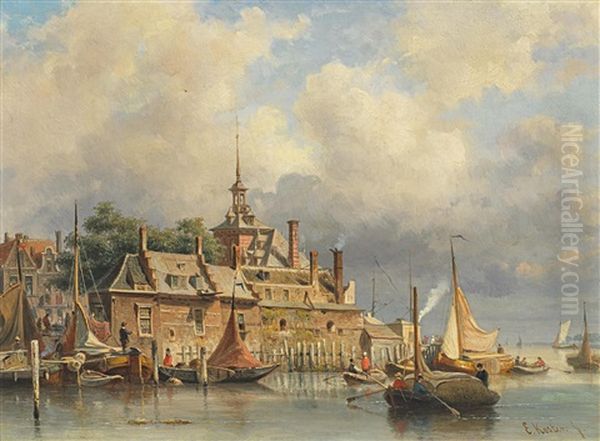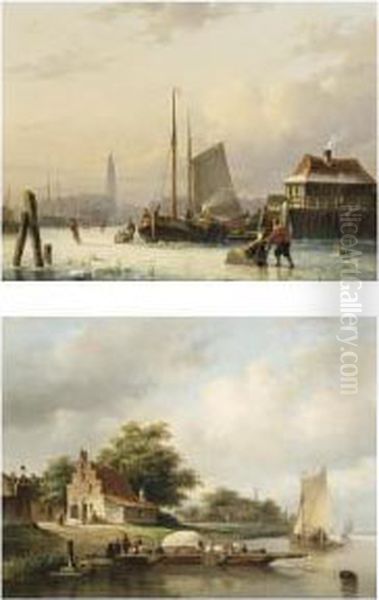
Everhardus Koster stands as a significant figure in the rich tapestry of 19th-century Dutch art. Born in Delft in 1817 and passing away in Dordrecht in 1892, Koster carved a distinguished career primarily as a painter of marine subjects, river scenes, and cityscapes. His meticulous technique, keen eye for detail, and ability to capture the interplay of light and water earned him considerable recognition during his lifetime, a reputation that endures through his presence in major museum collections and continued interest in the art market. As an artist navigating the transition from Romanticism towards the burgeoning realism of the Hague School, Koster developed a unique voice, blending technical precision with atmospheric sensitivity.
Early Life and Artistic Formation
Born into a Netherlands still deeply connected to its Golden Age artistic heritage, Everhardus Koster's journey as an artist began in Delft, a city historically associated with masters like Johannes Vermeer. His formal artistic education commenced at the prestigious Royal Academy of Art in The Hague. This institution provided a crucial foundation, grounding him in the academic principles of drawing, composition, and perspective that would underpin his later work.
During his time at the Academy, Koster studied under the guidance of Bartholomeus Johannes van Hove (1790-1880). Van Hove was himself a respected painter, known particularly for his detailed church interiors and cityscapes, often imbued with a Romantic sensibility. Studying with Van Hove likely honed Koster's appreciation for architectural accuracy and the careful rendering of light, elements that would become prominent in his own oeuvre. The artistic environment of The Hague at this time was vibrant, still feeling the influence of late Romanticism, with artists like Andreas Schelfhout setting high standards for landscape and winter scene painting, emphasizing detailed execution and picturesque compositions.
Developing a Style: Travels and Influences

Seeking to broaden his artistic horizons and refine his skills, Koster, like many ambitious artists of his era, embarked on travels beyond the Netherlands. He spent a significant period in Germany, furthering his studies at the Städelsches Kunstinstitut in Frankfurt am Main. This experience exposed him to different artistic traditions and likely introduced him to the works of German Romantic painters, potentially influencing his approach to landscape and atmosphere.
His travels also took him to England, particularly London. This period proved formative, offering Koster new subjects and perspectives. The bustling maritime activity of the Thames, the grand architecture, and the distinct atmospheric conditions of London provided rich material for his brush. It was during these travels and his subsequent return to the Netherlands, settling for a time in Amsterdam, that Koster solidified his specialization in marine and river scenes, alongside detailed cityscapes. He developed a reputation for a fine, precise painting style, meticulously rendering the details of ships, the textures of water, and the nuances of architecture. This dedication to accuracy echoed the traditions of earlier Dutch masters like the marine specialist Willem van de Velde the Younger or the cityscape painter Jan van der Heyden, yet Koster adapted this precision to the sensibilities and subjects of his own century.
Mastery of Marine and Cityscape Painting
Everhardus Koster's true métier lay in the depiction of water, whether the open sea, busy rivers, or tranquil canals within cities. He possessed a remarkable ability to capture the reflective qualities of water, the movement of waves, and the specific atmosphere created by different weather conditions and times of day. His seascapes often feature dramatic skies and meticulously rendered sailing vessels, showcasing his deep understanding of naval architecture and rigging – a hallmark shared with other esteemed Dutch marine painters such as Johannes Christiaan Schotel.
His cityscapes, particularly those of Dutch cities like Dordrecht and Amsterdam, as well as his views of London, demonstrate a similar commitment to detail. He rendered buildings with architectural accuracy, capturing the character of the urban environment. While grounded in reality, some of his works, like certain views of the River Thames, are noted for a subtle artistic license, perhaps slightly exaggerating the height of bridges or buildings to enhance the overall compositional drama and grandeur of the scene. This careful balance between topographical accuracy and artistic interpretation is a key feature of his style.

Koster's mastery extended beyond oil painting. He was also a skilled etcher and lithographer. A notable project involved a collaboration with the printmaker Johannes Hilverdink. Commissioned by the Amsterdam visual arts society 'Arti et Amicitiae', they produced an album of fine lithographs depicting Dutch city and harbor views. This project not only showcased Koster's versatility but also served a practical purpose, supporting him during a challenging period in his life.
Historical Subjects and Major Works
Beyond contemporary scenes, Koster also tackled historical subjects, particularly those related to Dutch maritime history. One of his most significant works in this vein is the large-scale oil painting William III Reviewing the Dutch Fleet. This impressive canvas, now housed in the Victoria and Albert Museum in London, demonstrates Koster's ability to handle complex compositions involving numerous figures, ships, and atmospheric effects, all while evoking a specific historical moment with grandeur and detail. Creating such works required considerable research into historical ship design, flags, and naval practices.
Another notable historical painting depicts a key moment from Abel Tasman's 1642 voyage, specifically the first encounters in New Zealand. Koster reportedly based his depiction on early charts and accounts, paying close attention to details such as the ornamentation of the Dutch ships and the traditional attire, including feathered headdresses, of the Māori figures. This painting highlights Koster's interest in historical accuracy and narrative. Its significance is underscored by its performance at auction; in 2004, a version of this subject sold for a substantial sum at Christie's, indicating the enduring appeal and perceived importance of his historical works. His engagement with historical themes places him alongside other 19th-century Dutch artists who depicted scenes from the nation's past, such as Nicolaas Pieneman and his father Jan Willem Pieneman.
Professional Life and Affiliations
Throughout his career, Everhardus Koster was actively involved in the Dutch art world. After his studies, he became a member of the Rijksakademie (Royal Academy) in Amsterdam, a prestigious affiliation that placed him at the heart of the city's artistic life. For a period, he held a significant position as curator or director at the Paviljoen Welgelegen in Haarlem, which at the time housed the Museum of Modern Art (Museum van Levende Nederlandsche Meesters). This role would have provided him with intimate access to the works of his contemporaries and further integrated him into the institutional framework of Dutch art.
His connection with 'Arti et Amicitiae' in Amsterdam was also important, as evidenced by the commissioned lithography project with Johannes Hilverdink. Membership in such societies provided artists with exhibition opportunities, professional networks, and mutual support. Later in his career, Koster moved back towards The Hague and Dordrecht, and sources suggest he held a directorial role associated with the museum of modern art in The Hague (likely the predecessor institution to the Kunstmuseum Den Haag), further cementing his status as a respected figure within the artistic establishment.
Personal Challenges and Resilience
Koster's artistic journey was not without significant personal obstacles. He suffered a severe accident that resulted in the loss of sight in one eye. For a painter, particularly one whose style relied on meticulous detail and careful observation, such an event could easily have ended his career. The commission from 'Arti et Amicitiae' for the lithograph series is sometimes viewed as an act of support from the artistic community during this difficult time, allowing him to continue working in a medium perhaps less demanding on his vision than oil painting.
Remarkably, however, Koster demonstrated incredible resilience. Reports indicate that after about a year of recovery and adaptation, he was able to resume painting in oils, overcoming his visual impairment to continue producing the detailed works for which he was known. This perseverance speaks volumes about his dedication to his craft. While biographical details mention that Koster experienced multiple marriages during his life, specific information about his family life remains scarce in the readily available sources.
Patronage and Collections
The quality and appeal of Koster's work attracted patrons and collectors. One notable figure was the third Baron de Ferrières (1824-1908), a significant collector who held Koster's work in high regard. The Baron's collection, which formed the basis of The Wilson art gallery and museum in Cheltenham, England, included works by Koster, highlighting the artist's international reach. The Baron's initial donation in 1898 featured several pieces by Dutch artists, indicating his appreciation for the art of the Netherlands, with Koster being among those he valued.
Today, Everhardus Koster's paintings and prints are held in numerous prestigious public collections across the Netherlands and internationally. In the Netherlands, his works can be found in the Rijksmuseum Amsterdam, the Amsterdam Museum, Museum Boijmans Van Beuningen in Rotterdam, the Kröller-Müller Museum in Otterlo, the Frans Hals Museum in Haarlem, and the Rotterdam Maritime Museum. Internationally, significant holdings are located in the UK, including the Victoria and Albert Museum and the British Museum in London, as well as The Wilson in Cheltenham. The continued presence of his works in auctions, with pieces like An der Mole vor Dordrecht and Schelde's Night Atmosphere appearing with respectable estimates, further attests to his enduring market appeal and the recognition of his artistic merit.
Context within Dutch Art
Everhardus Koster occupied an interesting position within the evolution of 19th-century Dutch art. His career bridged the gap between the detailed, often idealized landscapes of Dutch Romanticism, exemplified by artists like his teacher B.J. van Hove and Andreas Schelfhout, and the emergence of the Hague School later in the century. The Hague School, with leading figures such as Jozef Israëls, Anton Mauve, Hendrik Willem Mesdag, Jacob Maris, Matthijs Maris, Willem Maris, and Johan Hendrik Weissenbruch, favoured a looser, more atmospheric style, focusing on capturing the effects of light and mood, often in plein-air studies.
While Koster shared the Hague School's interest in Dutch light, water, and landscape/seascape subjects, his meticulous rendering and detailed finish often set him apart from their typically broader brushwork. He might be seen less as a core member and more as a contemporary whose work retained stronger ties to the earlier Romantic tradition of precise execution. However, his sensitivity to atmosphere and light certainly resonated with the broader artistic concerns of his time. He provided highly skilled, often picturesque, depictions of the Netherlands' maritime and urban identity during a period of national reflection and artistic renewal.
Legacy and Conclusion
Everhardus Koster left behind a substantial body of work characterized by technical proficiency, meticulous detail, and a deep affinity for marine and urban subjects. He excelled in capturing the specific character of Dutch waterways and city harbours, as well as undertaking ambitious historical maritime scenes. His ability to overcome personal adversity, namely the loss of an eye, to continue his successful career is a testament to his determination and passion for art.
His legacy is preserved not only in the numerous paintings and prints held by major museums but also in the continued appreciation shown by collectors and the art market. As a key figure in 19th-century Dutch marine and cityscape painting, Koster successfully navigated the artistic currents of his time, blending traditional Dutch precision with the atmospheric concerns that would lead towards the Hague School. He remains an important artist for understanding the richness and diversity of Dutch art during a century of significant change, celebrated for his skillful rendering of the nation's enduring relationship with water and its cities.